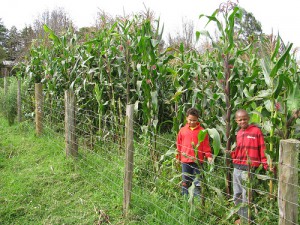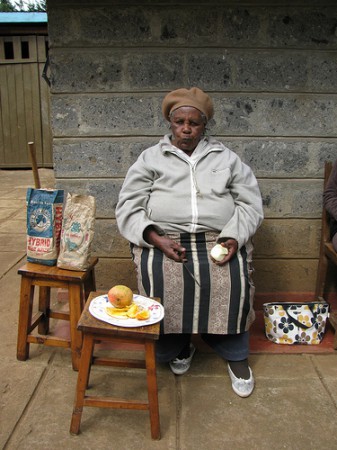What causes genetic erosion? People in our business are way too fond of making lists of all the things that can possibly lead to a farmer abandoning a variety. But sometimes it’s just down to an accident. Take my mother-in-law. Please. No, but seriously, this is an interesting example of the law of unintended consequences. Bear with me. The mother-in-law grows some hybrid maize on her spread in the Limuru highlands of Kenya. Here she is with a bag of the stuff, which she likes, despite the recurrent cost, because of the large cobs.
But she also grows a local landrace which she says goes back to before independence. It doesn’t yield as much, but it has thick juicy stems, and she needs that for her cows. So she grows both the hybrid and the landrace, not mixed up in the same field, but often side by side. Would be interesting to look at the geneflow that’s been happening up there over the years, but that’s not the point of this story.
 The point of the story is in fact that she almost lost the landrace recently. What happened is that last year she came to visit us in Rome for a few months, and left the farm in the otherwise quite capable hands of her daughter-in-law. Problem is, Violet, unaware of the preciousness of the landrace seed, went and fed most of it to the family. Fortunately, a handful or so survived, and quickly went into the ground for multiplication when grandma returned. You can see it here above. A close-run thing indeed. She says she would have been very upset if she had lost that seed, and asked me whether I could get it into Svalbard. After all, is that not my boss holding some seeds in front of the Vault? Well, yes, but…
The point of the story is in fact that she almost lost the landrace recently. What happened is that last year she came to visit us in Rome for a few months, and left the farm in the otherwise quite capable hands of her daughter-in-law. Problem is, Violet, unaware of the preciousness of the landrace seed, went and fed most of it to the family. Fortunately, a handful or so survived, and quickly went into the ground for multiplication when grandma returned. You can see it here above. A close-run thing indeed. She says she would have been very upset if she had lost that seed, and asked me whether I could get it into Svalbard. After all, is that not my boss holding some seeds in front of the Vault? Well, yes, but…

You could, perhaps, get it into CIMMYT’s genebank, and from there it would be a short hop to Norway …
Choose my mother….she has a way through with selecting the best quality cobs which are long and dent-like local landrace variety for the next planting season. These gives her hope in harvesting maize in bulk at her home in Sultan Hamud, Kenya, where the climatic conditions favours mostly the drought tolerant variety.when the season is favourable to farmers she opts to bring in hybrid variety which have vigour and reproduce many time compared to local landrace hence ensuring food sufficiency, then she stores a number of maize bags. She then uses maize stalks from the farm as hay.
I entrust and credit the CIMMYT organisation with coming up with the most improved maize and wheat hybrids and ensuring food security in the world.
I think there is a place in the ”market” for a “home” scale seed preservation kit based on silica gel and foil packaging for freezer /fridge storage. This would be valuable for small holder farmers or families to store a safety set of seed of their important germplasm. The breadth of its relevance was made apparent by the developed world lockdowns earlier this year which spiked demand for vegetable seed and exhausted commercial stocks. This in turn led many to realise that their old seed sitting in a warm damp shelf in the house was no longer viable. Perhaps a bit of profit from gardeners could fund distribution in poor parts of the world.
I couldn’t agree more, and in a former incarnation tried to get hold of smaller quantities of aluminium foil packets, which are quite easily sealed with a domestic iron and wire coat hanger. The idea was to distribute these to home seed savers, but the manufacturers of the foil packets were unwilling to supply small quantities to test the waters.
Maybe things would be different now.